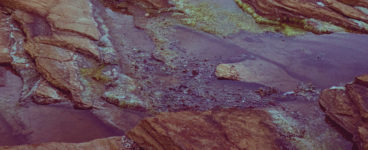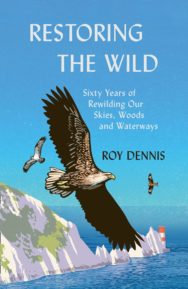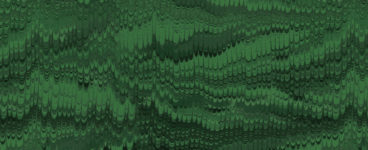‘If, in his hero Aldo Leopold’s famous phrase, we ‘think like a mountain’, and realise the interconnectedness of all living things, restoring nature’s balance will become feasible again.’
In reading Roy Dennis’s latest book, David Robinson discovers hope, inspiration, and a lot of hard work needed for the future of our wild spaces.
Restoring The Wild
By Roy Dennis
Published by William Collins
Most of the nature books on my shelves are really about people. In them, depression, divorce, alcoholism and grief all find a cure in nature, wildernesses are traversed with poetic purpose, rivers walked as psycho-geographical pilgrimage. They might tell me quite a bit about nature, but usually a lot more about their authors’ psyches: if I met them in the pub, I’d know what to expect.
Roy Dennis’s Restoring the Wild is different. It tells you so little about the man himself that no sooner had I finished its 430 pages than I wanted to find out more. Internet interviews reveal a kind-faced man who looks two decades younger than his 81 years, who still talks with the soft burr of his native Hampshire even though he has lived and worked in the Highlands and Islands since 1959. But here too, it’s the work that counts, not his personal feelings or emotive responses to nature: if you want raptures about raptors, you’ll have to look elsewhere. However, if you want to find out how to help wildlife survive, thrive, and expand their own horizons, Roy Dennis is the very man: according to the RSPB, no-one else has done more for nature conservation in Scotland in the last 100 years. Informed by sixty years of fieldwork, his new book is a comprehensive guide to how well – or poorly – we are placed to rewild our skies, woods and waterways.
The work he is most famous for – reintroducing birds of prey to their former habitats – began in 1967 when, as director of the Fair Isle Bird Observatory, he was asked to help re-establish the white-tailed sea eagle on these shores. Once, there would have been around 1200 breeding pairs in Britain. Poisoned by famers, shot by fishermen, they were last seen in Scotland on Skye in 1916.
Reintroducing lost species isn’t a new idea – the capercaillie had been hunted to extinction in the eighteenth century before it was brought back by Lord Breadalbane at Taymouth in 1837 – but there were plenty of potential obstacles to overcome before the Norwegian sea eagles could be brought across to Fair Isle. Crofters had to be won over (what if the birds preyed on lambs or sheepdogs?), collection and transportation arrangements made, hacking cages designed and built, and a host of decisions made about the amount of human contact the birds should have, how long they should be kept in their cages, the best place to release them, and how much food should be provided afterwards without them becoming dependent on it. On the plus side, the island’s 3,000 rabbits, with over a century to forget all about the danger of predation by sea eagles, didn’t bother to hide when they saw one – even though it looked, in the words of one crofter, ‘like a barn door flying across the sky’.
That first project failed, but lessons were learnt. The four birds brought over from arctic Norway were clearly not enough, and subsequent releases in Scotland were made nearer sheltered cliffs where the young eagles wouldn’t be mobbed by gulls. These days, there are 140 pairs of white-tailed sea eagles ranging from Mull (where their value in ecotourism has been estimated at £5m a year) to Orkney. A 2007 attempt to establish them on the marshy Suffolk coast failed in the wake of a series of sensationalist stories about their potential threats to piglets, Christmas turkeys and bitterns, but a recent project to reintroduce them on the Isle of Wight appears to be succeeding.
Aren’t Suffolk and the Isle of Wight too er, douce for our wildest avian predators? Not at all, says Dennis. Nearly all of this land was their land once. The Isle of Wight-reared white-tailed sea eagle flying he tracked flying above the House of Commons might have had ancestors who fed on its land long before there was a parliament there, never mind a city. And not just raptors: storks used to nest (they did in 1680 anyway) on St Giles’ cathedral in Edinburgh, so why not again? Cranes give their name to more places in Scotland than any other bird (Cranloch, Cranstoun, Cranbeg Moss), and it would be good to welcome them back. Wolves howled in woods near our villages only three centuries ago – and should, Dennis insists, do so again, brought back along with lynx, elk and wild boar, so that our forests are no longer ‘ecologically dead’. Bears, too, belong here: according to the Roman poet Martial, the brown bears in the Colosseum in 80AD came from Scotland. Certainly beavers should again dam our streams, and not just in the remoter parts of the country either. Reintroducing the beaver is, says Dennis, a no-brainer: at a time of climate breakdown, we desperately need the ecosystems they provide, just as we need them to ameliorate floods and purify polluted waters. Farmers might complain at the damage beavers cause to riverbank crops, but they shouldn’t be growing them there anyway, what with the dangers of chemical run-off, and riverine trees the beavers could get their teeth into would be better for them and humans alike.
Projects to bring back all of these species to Scotland have at least been talked about in the last 60 years, although in most cases talk is all it has amounted to. But Restoring The Wild can point out some successes too: the defence of the red squirrel and the return of overwintering goldeneye ducks in the Highlands, the reintroduction of the red kite in both Scotland (the Black Isle) and England (the Chilterns), and of course, the recovery of the osprey from a single pair in the 1950s to close on 200 breeding pairs today, a programme further boosted by their 2001 reintroduction to Rutland Water. Dennis has played a key role in all of these projects, along with the reintroduction of the golden eagle to Ireland and of the white-tailed sea eagle to the Isle of Wight, but is modest about his role and is unfailngly generous about crediting other participants.
Perhaps, in fact, he is too modest to offer a specific manifesto for rewilding, although his book suggests the outline of one. We shouldn’t, he says, have to go to nature reserves to see nature: instead, we should give over half of our land to wildlife, and not just the impoverished uplands. It will take time to restore a fully functioning ecosystem with larger carnivores – it was, he points out, a full 60 years before the 1930s plans for Yellowstone National Park were implemented – but as our degraded land recovers from overgrazing by sheep and deer, and more extinct native species are reintroduced, ecotourism will flourish. If, in his hero Aldo Leopold’s famous phrase, we ‘think like a mountain’, and realise the interconnectedness of all living things, restoring nature’s balance will become feasible again.
It won’t be easy. If Dennis’s experience is anything to go by, the greatest opposition often comes from people one might expect to be on the same side. They’ll be too attached to their own projects to spare young birds for rewilding projects elsewhere, they’ll insist on lengthy feasibility studies or guidelines that don’t make sense, suggest alternative sites for translocation or prioritise plans to save another species. Meanwhile, choices narrow, priorities change, funding dries up, supporters move on. Not for nothing does Dennis title one of his chapters Endurance and another Bureaucracy.
Against that, the rewilders have their own networks too, often usefully international: bringing back the goldeneye depended on Swedish expertise, reintroducing the white-tailed sea eagles on the generosity of the Norwegians (although not so much at the start, when they still regarded the bird as a pest). Nothing makes this interconnectedness clearer than satellite tracking. Dennis was involved in this back in 1999, when he caught the first osprey for satellite tagging, expecting to find it overwintering in west Africa only to discover that it had settled on Spain instead.
I began with the white-tailed sea eagle, so I’ll end with one too – not from Dennis’s first, failed Fair Isle project but his latest one on the Isle of Wight. It’s a story about two young birds, G463 (a male) and G405 (a female), and their mapped early spring wanderings over England, Belgium and Germany and England and Scotland respectively. By the time you read this, they will have flown elsewhere, but at the end of April, you could have followed them on Dennis’s website (www.roydennis.org/category/latest-news), watching G463 become the first of the Isle of Wight ospreys to venture across the English Channel and discover the joys of Schleswig-Holstein (a great place for sea eagles, apparently), and G405 fly up to the Lammermuirs before heading back south.
On the website map, we can watch as they fly across borders. We know where they roost each night, whether they are flying with or against the wind, their height, speed, the landscape they’d see beneath them, even some of their prey. But we don’t yet know how strong their grasp on our world will turn out to be – whether G463 will return with a mate and help link up the European and English sea eagles, whether G405 would ever consider flying even further north next time, or whether they will further strengthen Roy Dennis’s hopes for a rewilded future. Yet oddly – especially oddly for a townie who can’t tell the difference between a sea eagle, a buzzard and a great bustard – I’m hooked by the challenge his book sets out.
Restoring The Wild by Roy Dennis is published by William Collins, priced £18.99
ALSO IN THIS ISSUE

 An Orkney Tapestry
An Orkney Tapestry
‘The wind is rarely still. It shifts from airt to airt, and everything – flowers, clouds, birds, ani …














